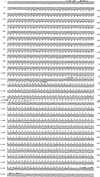Evidence for horizontal transfer of the EcoT38I restriction-modification gene to chromosomal DNA by the P2 phage and diversity of defective P2 prophages in Escherichia coli TH38 strains
- PMID: 12644501
- PMCID: PMC151499
- DOI: 10.1128/JB.185.7.2296-2305.2003
Evidence for horizontal transfer of the EcoT38I restriction-modification gene to chromosomal DNA by the P2 phage and diversity of defective P2 prophages in Escherichia coli TH38 strains
Abstract
A DNA fragment carrying the genes coding for a novel EcoT38I restriction endonuclease (R.EcoT38I) and EcoT38I methyltransferase (M.EcoT38I), which recognize G(A/G)GC(C/T)C, was cloned from the chromosomal DNA of Escherichia coli TH38. The endonuclease and methyltransferase genes were in a head-to-head orientation and were separated by a 330-nucleotide intergenic region. A third gene, the C.EcoT38I gene, was found in the intergenic region, partially overlapping the R.EcoT38I gene. The gene product, C.EcoT38I, acted as both a positive regulator of R.EcoT38I gene expression and a negative regulator of M.EcoT38I gene expression. M.EcoT38I purified from recombinant E. coli cells was shown to be a monomeric protein and to methylate the inner cytosines in the recognition sequence. R.EcoT38I was purified from E. coli HB101 expressing M.EcoT38I and formed a homodimer. The EcoT38I restriction (R)-modification (M) system (R-M system) was found to be inserted between the A and Q genes of defective bacteriophage P2, which was lysogenized in the chromosome at locI, one of the P2 phage attachment sites observed in both E. coli K-12 MG1655 and TH38 chromosomal DNAs. Ten strains of E. coli TH38 were examined for the presence of the EcoT38I R-M gene on the P2 prophage. Conventional PCR analysis and assaying of R activity demonstrated that all strains carried a single copy of the EcoT38I R-M gene and expressed R activity but that diversity of excision in the ogr, D, H, I, and J genes in the defective P2 prophage had arisen.
Figures






Similar articles
-
Evidence of horizontal transfer of the EcoO109I restriction-modification gene to Escherichia coli chromosomal DNA.J Bacteriol. 1999 Nov;181(21):6822-7. doi: 10.1128/JB.181.21.6822-6827.1999. J Bacteriol. 1999. PMID: 10542186 Free PMC article.
-
Natural C-independent expression of restriction endonuclease in a C protein-associated restriction-modification system.Nucleic Acids Res. 2016 Apr 7;44(6):2646-60. doi: 10.1093/nar/gkv1331. Epub 2015 Dec 9. Nucleic Acids Res. 2016. PMID: 26656489 Free PMC article.
-
Cloning and characterization of the unusual restriction-modification system comprising two restriction endonucleases and one methyltransferase.Gene. 1995 May 19;157(1-2):49-53. doi: 10.1016/0378-1119(94)00796-u. Gene. 1995. PMID: 7607524
-
[Regulation of gene expression in type II restriction-modification system].Genetika. 2008 May;44(5):606-15. doi: 10.1134/s1022795408050037. Genetika. 2008. PMID: 18672793 Review. Russian.
-
Conflicts targeting epigenetic systems and their resolution by cell death: novel concepts for methyl-specific and other restriction systems.DNA Res. 2010 Dec;17(6):325-42. doi: 10.1093/dnares/dsq027. Epub 2010 Nov 8. DNA Res. 2010. PMID: 21059708 Free PMC article. Review.
Cited by
-
Evolutionary genome engineering using a restriction-modification system.Nucleic Acids Res. 2011 Nov 1;39(20):9034-46. doi: 10.1093/nar/gkr585. Epub 2011 Jul 23. Nucleic Acids Res. 2011. PMID: 21785135 Free PMC article.
-
Identification of a gene encoding a functional reverse transcriptase within a highly variable locus in the P2-like coliphages.J Bacteriol. 2006 Feb;188(4):1643-7. doi: 10.1128/JB.188.4.1643-1647.2006. J Bacteriol. 2006. PMID: 16452449 Free PMC article.
-
Whole genomic DNA sequencing and comparative genomic analysis of Arthrospira platensis: high genome plasticity and genetic diversity.DNA Res. 2016 Aug;23(4):325-38. doi: 10.1093/dnares/dsw023. Epub 2016 Jun 21. DNA Res. 2016. PMID: 27330141 Free PMC article.
-
Mining bacterial NGS data vastly expands the complete genomes of temperate phages.NAR Genom Bioinform. 2022 Aug 3;4(3):lqac057. doi: 10.1093/nargab/lqac057. eCollection 2022 Sep. NAR Genom Bioinform. 2022. PMID: 35937545 Free PMC article.
-
Domain movement within a gene: a novel evolutionary mechanism for protein diversification.PLoS One. 2011 Apr 14;6(4):e18819. doi: 10.1371/journal.pone.0018819. PLoS One. 2011. PMID: 21533192 Free PMC article.
References
-
- Anton, B. P., D. F. Heiter, J. S. Benner, E. J. Hess, L. Greenough, L. S. Moran, B. E. Slatko, and J. E. Brooks. 1997. Cloning and characterization of the BglII restriction-modification system reveals a possible evolutionary footprint. Gene 187:19-27. - PubMed
-
- Bertani, G., and E. Six. 1958. Inheritance of prophage P2 in bacterial crosses. Virology 6:357-381. - PubMed
-
- Blattner, F. R., G. Plunkett III, C. A. Bloch, N. T. Perna, V. Burland, M. Riley, J. Collado-Vides, J. D. Glasner, C. K. Rode, G. F. Mayhew, J. Gregor, N. W. Davis, H. A. Kirkpatrick, M. A. Goeden, D. J. Rose, B. Man, and Y. Shao. 1997. The complete genome sequence of Escherichia coli K-12. Science 277:1453-1461. - PubMed
MeSH terms
Substances
Associated data
- Actions
LinkOut - more resources
Full Text Sources
Molecular Biology Databases
Miscellaneous

